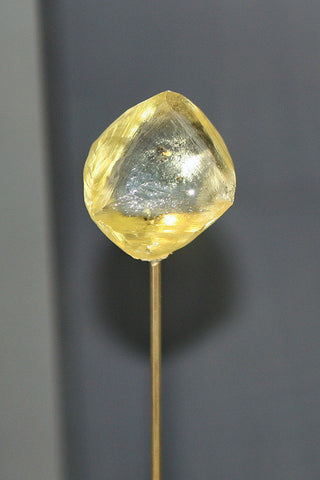 The birthstone of the month of April is the diamond. The diamond is surrounded by many different stories, most of which involve eternal love and wealth. The ancient Hindus gave the diamond the name "Vajra" (which means lightening), because of the way it reflects light and its extreme hardness. Unlike the Hindus the ancient Greeks believed that the fire of a diamond reflected the flame of everlasting love. The Archduke Maximilian of Austria agreed with them and in 1477, he gave a diamond ring to his fiancee, Mary of Burgundy, which is when the tradition of proposing with a diamond ring to show affection and eternal love began. The Greeks also believed that the diamond held magical powers, because they thought that the stone was either stars, which had fallen from heaven or the tears of the gods. For this reason diamonds were often worn into battle as a symbol of strength, courage and protection.
The birthstone of the month of April is the diamond. The diamond is surrounded by many different stories, most of which involve eternal love and wealth. The ancient Hindus gave the diamond the name "Vajra" (which means lightening), because of the way it reflects light and its extreme hardness. Unlike the Hindus the ancient Greeks believed that the fire of a diamond reflected the flame of everlasting love. The Archduke Maximilian of Austria agreed with them and in 1477, he gave a diamond ring to his fiancee, Mary of Burgundy, which is when the tradition of proposing with a diamond ring to show affection and eternal love began. The Greeks also believed that the diamond held magical powers, because they thought that the stone was either stars, which had fallen from heaven or the tears of the gods. For this reason diamonds were often worn into battle as a symbol of strength, courage and protection.
 Diamonds, which are in reality nothing more than crystallized carbon, are formed deep inside the earth and come to the surface through volcanic eruptions. They are found in a stone called kimberlite, a very hard volcanic-earth mixture, which gets crushed by big steel rollers in order to get to the diamond. The steel rollers crush the kimberlite into gravel, but leave the diamonds often hidden inside the stone unharmed. The diamond, which is four times as strong as the next hardest natural mineral has since early times been used for carving, cutting and drilling other stones and materials such as jade, pearl and glass. However, despite its hardness, even the diamond has its weaknesses. The diamond has what is called 'four directions of cleavage', which means that if the stone gets a hard hit at one of those points it is likely to crack or split. A good stone setter will however know where these points are and make sure that none of them lay in the open, making the stone/jewelry practically unbreakable. In jewelry terms, the hardness of a diamond is referred to as a 10 and is unmatched by any other substance. Nothing, except for another diamond can scratch a diamond. Another interesting plus point of the diamond is its clarity. A pure diamond is known for its transparent color, which is unmatched by any other substance, be it liquid or solid. The diamond also has a very high heat acceptance, which is why the simplest test to see whether a diamond is real or not is to heat it up.
Diamonds, which are in reality nothing more than crystallized carbon, are formed deep inside the earth and come to the surface through volcanic eruptions. They are found in a stone called kimberlite, a very hard volcanic-earth mixture, which gets crushed by big steel rollers in order to get to the diamond. The steel rollers crush the kimberlite into gravel, but leave the diamonds often hidden inside the stone unharmed. The diamond, which is four times as strong as the next hardest natural mineral has since early times been used for carving, cutting and drilling other stones and materials such as jade, pearl and glass. However, despite its hardness, even the diamond has its weaknesses. The diamond has what is called 'four directions of cleavage', which means that if the stone gets a hard hit at one of those points it is likely to crack or split. A good stone setter will however know where these points are and make sure that none of them lay in the open, making the stone/jewelry practically unbreakable. In jewelry terms, the hardness of a diamond is referred to as a 10 and is unmatched by any other substance. Nothing, except for another diamond can scratch a diamond. Another interesting plus point of the diamond is its clarity. A pure diamond is known for its transparent color, which is unmatched by any other substance, be it liquid or solid. The diamond also has a very high heat acceptance, which is why the simplest test to see whether a diamond is real or not is to heat it up.
The refraction and the dispersion are two more factors that make the diamond so desirable. Refraction is the stones ability to bend light, which gives it the high lustre called adamantine. The diamond also has what is considered a high optical dispersion, which gives the stone its desired fire. Most people know the diamond in it's yellow/white/transparent form, but the stone also comes in blue, red, green, brown and black (some of which are extremely valuable).
Have we piqued your curiosity? Check out how to select a diamond for engagement rings, wedding jewelry and other custom designs to learn more about how we ethically source, reuse heirloom diamonds and understand diamonds.
Rough Uncut Photo Credit: Flickr.com - cliff1066
